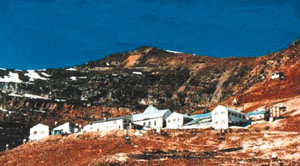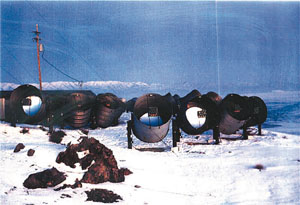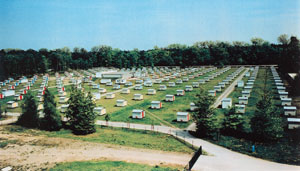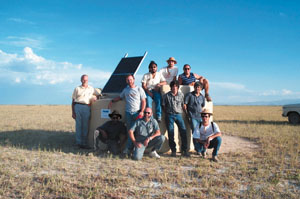A recent meeting in Bolivia looked at the possibilities of mounting new physics instrumentation at the highest-altitude laboratory in the world. Larry Jones reports.


Before the advent of particle accelerators, cosmic rays were the source of many major physics discoveries. A physicists realize that the energies attainable using terrestrial accelerators represent only a tiny slit of nature’s wide window, cosmic ray physics is becoming fashionable once more.
A recent meeting of cosmic ray physicists in La Paz, Bolivia, examined the research programme of the Chacaltaya Laboratory, one motivation being the recent declaration of support for the laboratory by the Centro Latinoamericano de Fisica.
At 5220 m (540 g/cm2 barometric pressure), Chacaltaya is the highest continuously operating cosmic ray research laboratory in the world and barely an hour’s drive from the outskirts of La Paz.
Several speakers recalled the early history of the laboratory, including the discovery of the pion in nuclear emulsions by Lattes, Occhialini and Powell (seen also in emulsions exposed on the Pic du Midi in the Pyrenees). Other unusual emulsion chamber observations include the still mysterious Centauro events.
Local experiments
Several reports came from experimental collaborations currently working at Chacaltaya. The Bolivian Airshower Joint Experiment (BASJE) group’s work was discussed by H Yoshii (Ehime) and others. This collaboration, operating since 1962, currently utilizes an array of about 80 scintillation detectors in a 60 x 60 m array.
An interesting result is the observation of a galactic anisotropy in arrival directions, an enhancement of the primary cosmic ray flux between 270° and 300° galactic longitude. As the events showing this anisotropy have a normal muon content, the conclusion is that the effect is due to primary cosmic ray nuclei and not gamma rays.
A Ohsawa (Institute for Cosmic Ray Research, Tokyo) and N Ohmori (Koshi) discussed results from the Saytama Yamanashi-San Andres (SYS) collaboration detector – an array of 32 emulsion chambers, each 0.25 m2 and each containing 15 cm of lead plates, mounted on a thick scintillator. This array opens up the study of the hadron component of an air shower core in correlation with the electromagnetic component.
Among the conclusions based on their observations are a confirmation of a breakdown of Feynman (kinematic) scaling at energies of 1 PeV (1015 eV) and above; a scarcity of hadrons compared with the predictions from simulations; and a decrease in inelasticity with increasing energy (inelasticity is the average value of 1-K, where K is the fraction of the incident energy retained by the most energetic hadron in the final state of a nuclear interaction).
M de Petris (Rome) described the Millimetre Observations from a high-altitude 2.6 m ground-based telescope (MITO) infrared telescope programme at 3500 m on Testa Grigia, Italy, for infrared astronomy over the 30-0.6 mm wavelength range. One stated goal is “the multifrequency observation of rich large clusters of galaxies to estimate, together with X-ray information, the Hubble constant”. As these wavelengths are strongly absorbed by atmospheric water vapour, which falls off more rapidly than barometric pressure with altitude, such observations profit particularly from high-altitude locations, and the advantages of locating such a facility at Chacaltaya were pointed out.
Nuclear content

The SYS group also reported that the (logarithmic) average nuclear composition of the primary cosmic rays at an energy of 10 PeV was about that of oxygen. This is somewhat lower than the BASJE data had suggested; BASJE (and others) argue that the composition at this energy is heavier, with iron nuclei dominant. On the other hand, studies of the atmospheric Cherenkov radiation accompanying air showers have suggested a lighter nuclear spectrum at this energy.
J Stamenov (Bulgarian Academy of Sciences) and J Procureur (Bordeaux) presented a proposal to select showers generated by primaries with different masses but the same energy to a possible future extended air shower array at Chacaltaya.
Other activities on Mount Chacaltaya that were discussed included a Search for Light Magnetic Monopoles (SLIM) with a 100 m2 (expandable to 400 m2 in the future) passive nuclear track detector consisting of three sheets of CR-39 track etch detector sheets, three Makrofol sheets and an aluminium absorber, as reported by S Cecchini (Bologna). SLIM could also be sensitive to “strangelets”, as discussed by G Wilk (Warsaw). A strangelet (strange quark matter or “nuclearite”) would be a nuclear object containing approximately equal numbers of up, down and strange quarks.
Searches for high-energy gamma-ray point sources with the SYS array were presented by R Bustos (La Paz) and searches for gamma-ray “bursters” with the INCA experiment (Investigation on Cosmic Anomalies) by S Vernetto (Turin). Results of both searches were negative. However, Vernetto showed that the INCA experiment at Chacaltaya has provided the lowest upper limits on gamma-ray bursters from a GeV-TeV ground-based experiment. Also reported were high-altitude studies of background ionizing radiation at Chacaltaya by S Cecchini, and a neutron monitor installation by E Cordaro (Santiago).
Bending the knee

The cosmic ray spectrum changes behaviour at a “knee” (between 1 and 10 PeV). Studying this effect, the flux is too low for direct observation using small balloon- or satellite-borne detectors, and earth-based observations must interpret indirect observables such as air-shower (electron and gamma ray) components, muons and hadrons in terms of primary interaction and the mass composition.
The simulations for the primary interaction are based on long extrapolations from sub-TeV accelerator data and are hence uncertain. The primary cosmic rays range from protons to iron nuclei. The problem is that the observable consequences of the composition and characteristics of the primary interaction are interrelated.
The KASCADE array at Karlsruhe is probably the most densely instrumented air shower array in operation. A Haungs (Karlsruhe) reported on recent work. Analysis of the hadron and electromagnetic components shows that the spectrum of light primaries shows a clear break (the knee), while the heavy primary spectrum is relatively smooth. This results in an increase in average nuclear mass with energy through the knee region. The Karlsruhe group has found no existing Monte Carlo model to be totally satisfactory at energies of 10 PeV and above and is tuning a promising new candidate.
An analogue of the KASCADE array at the elevation of Chacaltaya was presented by O Saavedra (Turin). A central hadron calorimeter/muon detector of perhaps 100 m2 with finely instrumented upper layers would be surrounded by a dense air shower array, including additional muon detectors. Although an ambitious project, this could go a long way towards resolving the confusion and contradictions surrounding the composition, the primary spectrum and the physics around the knee of the cosmic ray spectrum.
The Japanese and the Russians have exploited an emulsion chamber array in the Pamirs. Aspects of this research were presented by M Tamada (Kinki, Osaka), T Yuldashbaev (Tashkent), and S Slavatinsky and A Borisov (Lebedev Institute, Moscow). They compared their data with a quark-gluon string model, concluding that inelasticity increases with energy, contrary to the SYS conclusions.
Slavatinsky also emphasized unusual phenomena seen in their emulsion chambers – “aligned events”, “halo events” and the “long-flying component”. The latter was interpreted by Z Wlodarczyk (Kielce) as possible evidence for strangelets, which, he noted, might also be the source of the mysterious Centauros. J N Capdevielle (Paris) and S Nikolsky (Moscow) presented possible evidence for quark-gluon plasma in emulsion chambers.








